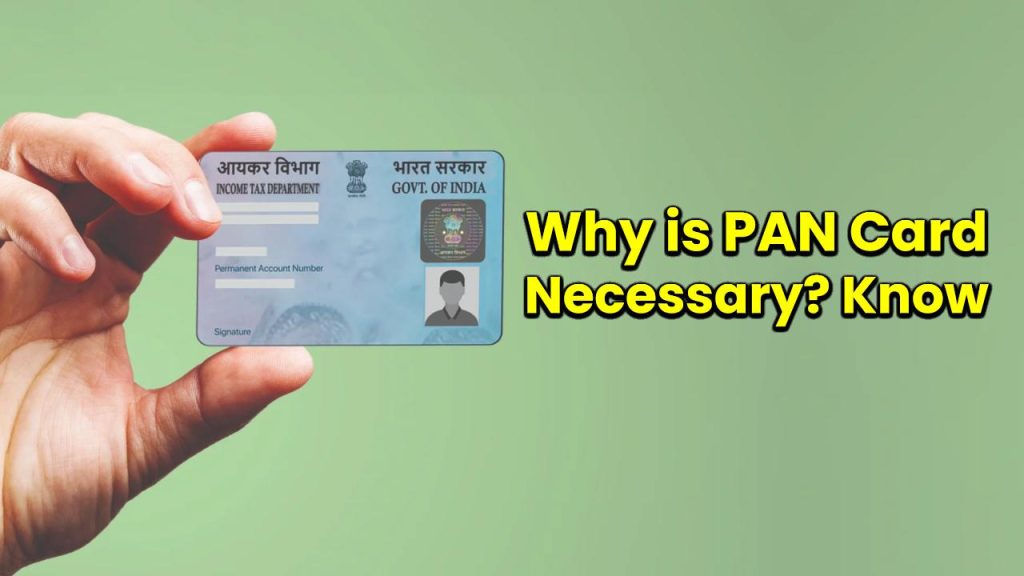
A PAN Card is more than just a tool for paying taxes in India. While most people recognize it as a requirement for filing income tax returns, few realize just how essential this document has become in daily financial activities. Whether you are a student, a salaried employee, a business owner, or even a senior citizen, having a PAN Card simplifies a wide range of transactions.
In this article, we’ll break down why PAN Card is necessary and highlight where it is used apart from paying tax. We’ll also offer practical tips, official resources, and clear examples to help you understand the role of PAN Card in India.
Why is PAN Card Necessary?
| Feature | Details |
|---|---|
| Full Form of PAN | Permanent Account Number |
| Issued By | Income Tax Department, Government of India |
| Structure | 10-character alphanumeric code (e.g., ABCDE1234F) |
| Primary Use | Tax identification and filing |
| Additional Uses | Bank accounts, property transactions, investments, loans, KYC, large purchases, and more |
| Mandatory For | Transactions exceeding Rs. 50,000, property & vehicle purchases, mutual fund investments, etc. |
To sum up, a PAN Card is necessary not just for paying taxes but for a multitude of financial activities. From opening a bank account to buying property, investing in mutual funds, or even purchasing jewelry, your PAN card plays a crucial role in ensuring compliance and transparency. Whether you’re a salaried employee, business owner, or student, having a PAN card simplifies your financial life.
What Is a PAN Card?
The PAN Card (Permanent Account Number) is a 10-digit unique alphanumeric identifier issued by the Income Tax Department of India. It is linked to all your financial transactions and acts as proof of identity. Every individual, business, or entity conducting financial activities in India must have a PAN Card.
A PAN Card looks like a simple laminated card but carries immense importance. It contains details like:
- Full Name
- Father’s Name
- Date of Birth
- PAN Number
- Photograph
- Signature
see also: Don’t Have a Credit History?
Why Is PAN Card Necessary?
1. Mandatory for Filing Income Tax
The primary purpose of a PAN Card is to help the Income Tax Department keep track of your tax payments. Whether you’re an employee, freelancer, or business owner, you can’t file income tax returns without quoting your PAN.
Example: If you earn over Rs. 2.5 lakh annually, you are required to file taxes—and your PAN will be your unique tax identifier.
2. Opening a Bank Account
Most banks, both private and public, require PAN details to open savings or current accounts. This is part of the Know Your Customer (KYC) process, ensuring transparency and preventing fraud.
Example: Without a PAN, you cannot open an account in banks like SBI, HDFC, or ICICI.
3. Large Cash Deposits and Withdrawals
According to RBI guidelines, quoting PAN is mandatory when depositing or withdrawing Rs. 50,000 or more in cash at banks.
Example: If you deposit Rs. 60,000 in your account, the bank will request your PAN card details.
4. Purchasing High-Value Assets
PAN Card is essential for:
- Buying/selling immovable property worth Rs. 10 lakh or more.
- Buying vehicles (excluding two-wheelers).
Example: Planning to buy a house worth Rs. 50 lakh? You need to furnish your PAN details during registration.
5. Investments in Mutual Funds, Shares & Bonds
Investment instruments such as mutual funds, stocks, or fixed deposits exceeding Rs. 50,000 require PAN verification.
Example: Investing Rs. 1 lakh in mutual funds? PAN details are a must to process your KYC.
6. Applying for Loans & Credit Cards
Whether it’s a home loan, personal loan, or credit card application, financial institutions mandate PAN to assess your creditworthiness and maintain financial transparency.
Example: Applying for a credit card at Axis Bank? You’ll be asked for PAN proof.
7. Foreign Currency Exchange
For foreign exchange transactions exceeding Rs. 50,000, PAN is compulsory.
Example: If you’re planning an international trip and exchanging Rs. 1 lakh worth of foreign currency, the exchange dealer will require your PAN.
8. Life Insurance Premium Payments
When you pay life insurance premiums above Rs. 50,000 annually, insurance companies require PAN for compliance.
9. Buying Jewelry Over Rs. 2 Lakh
The Government of India mandates quoting PAN when buying jewelry valued at Rs. 2 lakh or more to curb black money transactions.
10. Proof of Identity
Besides financial transactions, PAN card is widely accepted as a valid identity proof across various sectors.
Example: Many employers, universities, or service providers accept PAN as official ID.
Where Can You Apply for a PAN Card?
Applying for a PAN Card is easy and can be done both online and offline:
- Online Application: Visit NSDL PAN Portal or UTIITSL Portal and fill Form 49A.
- Offline Application: Visit a PAN service center, fill out Form 49A, attach required documents, and submit.
Required Documents for PAN Application
- Proof of Identity: Aadhaar Card, Passport, Voter ID, or Driving License
- Proof of Address: Utility bill, Bank statement, or Passport
- Photograph: Two recent passport-sized photos
see also: More Savings on Interest Income from April 1
PAN Card FAQs
1. Is it mandatory to link PAN with Aadhaar?
Yes, as per government directives, linking PAN with Aadhaar is mandatory to ensure your PAN remains active.
2. Can I hold multiple PAN cards?
No, holding multiple PAN cards is illegal and can attract penalties.
3. What happens if I don’t have a PAN card?
Without a PAN, you may face issues in financial transactions, tax filing, and may even attract higher TDS (Tax Deducted at Source).
4. Is PAN necessary for students?
If a student earns income above Rs. 2.5 lakh annually or wants to open a bank account, a PAN card is necessary.
5. How long does it take to get a PAN card?
Typically, after successful application and document verification, it takes around 15-20 days to receive a PAN card.











